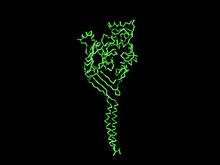Acid-sensing ion channel

Acid-Sensing Ion Channels (ASICs) are neuronal voltage-insensitive sodium channels activated by extracellular protons.[1] ASIC proteins are a subfamily of the ENaC/Deg superfamily of ion channels. In mammalian genomes, the ASIC is encoded by five genes, ASIC1, ASIC2, ASIC3, ASIC4, and ASIC5.[2] These genes have splice variants that encode for several isoforms that are marked by a suffix. For example, two major products of ASIC1 gene are called as ASIC1a and ASIC1b. ASICs are trimeric and can be made up of different combinations of subunits. ASIC2b is non-functional on its own but modulates channel activity when participating in heteromultimers. ASIC4 has no known function. All ASICs are expressed in the peripheral nervous system while ASIC1a, 2a, 2b, 3 and 4 are expressed in the central nervous system. ASICs are Na+ permeable with ASIC1a showing low Ca++ permeability.
Structure
The crystal structure of chicken ASIC1a was solved in 2007.[3] The structure of ASIC1a has also served as a model to understand the structure of the homologous epithelial sodium channel ENaC.[2][4] In contrast to ASIC1 structure that is a homotrimer, ENaC is assembled as a heterotrimer composed of three homologous subunits α, β, and γ or δ, β, and γ encoded by SCNN1A, SCNN1B, SCNN1G, and SCNN1D.[4]
Physiology
ASICs are potential drug targets for treating a wide variety of conditions linked to both the CNS and PNS.[5] Of particular interest to pain field is the ASIC3 subtype receptor, which is specifically expressed in nociceptors. This subtype exhibits a biphasic current upon proton activation, where the initial inward Na+ current is shortly followed by a sustained cationic current.
Pharmacology
ASICs are activated by protons (H+). The concentration of H+ required to open the channel varies with the channels subunit composition (pH from 7 to 5). A snake toxin (MitTx) was recently shown to directly activate ASIC channels and cause pain in mice.
The diuretic amiloride blocks ASICs by acting as pore blocker.
Two animal toxins have been shown to inhibit ASICs channel function. Psalmotoxin-1 (PcTx1) specifically inhibits ASIC1a homomultimeric channels with sub-nanomolar affinity. The sea anemone toxin APETx2 inhibits ASIC3-containing channels with IC50<100 nM.
Results first reported in Nature in October 2012 suggest that a newly discovered class of three-finger peptides from the venom of the black mamba, named mambalgins by the researchers, suppress pain in mice without toxicity and with fewer side effects than morphine. The analgesic effects are believed to involve "blockade of heteromeric channels made of ASIC1a and ASIC2a subunits in central neurons and of ASIC1b-containing channels in nociceptors".[6][7]
References
- ↑ Gründer, S; Pusch, M (July 2015). "Biophysical properties of acid-sensing ion channels (ASICs).". Neuropharmacology. 94: 9–18. PMID 25585135.
- 1 2 Hanukoglu I (2016). "ASIC and ENaC type sodium channels: Conformational states and the structures of the ion selectivity filters". FEBS Journal. doi:10.1111/febs.13840. PMID 27580245.
- ↑ Jasti J, Furukawa H, Gonzales EB, Gouaux E (September 2007). "Structure of acid-sensing ion channel 1 at 1.9 A resolution and low pH.". Nature. 449 (7160): 316–323. doi:10.1038/nature06163. PMID 17882215.
- 1 2 Hanukoglu I, Hanukoglu A (Jan 2016). "Epithelial sodium channel (ENaC) family: Phylogeny, structure-function, tissue distribution, and associated inherited diseases.". Gene. 579 (2): 95–132. doi:10.1016/j.gene.2015.12.061. PMID 26772908.
- ↑ Sluka KA, Winter OC, Wemmie JA (September 2009). "Acid-sensing ion channels: A new target for pain and CNS diseases". Curr Opin Drug Discov Devel. 12 (5): 693–704. PMID 19736627.
- ↑ Diochot, S.; Baron, A.; Salinas, M.; Douguet, D.; Scarzello, S.; Dabert-Gay, A. S.; Debayle, D.; Friend, V. R.; Alloui, A.; Lazdunski, M.; Lingueglia, E. (2012). "Black mamba venom peptides target acid-sensing ion channels to abolish pain". Nature. 490 (7421): 552–555. doi:10.1038/nature11494. PMID 23034652.
- ↑ Gallagher, James (3 October 2012). "Black mamba venom is 'better painkiller' than morphine". BBC News Health. BBC. Retrieved 3 October 2012.